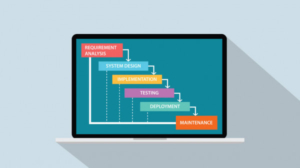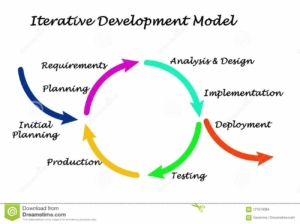Introduction
It is essential to ensure that the software is of the highest quality to gain profit in the competitive market. The software development lifecycle model requires a proper implementation to ensure that the software product is ready for launch. Let us know more about the meaning of the software development lifecycle before understanding the top 2 software development models.
What is the software development lifecycle?
Software development lifecycle is a sequential process to develop high-quality software. Planning and requirement analysis, design, product development, testing, deployment and maintenance are the steps for the software development lifecycle. The goal of this process is to enhance the software for a better customer experience.
Following are the most popular models for software development lifecycle:
1) Waterfall model

This image is taken from https://www.depositphotos.com
Key feature
There is more focus on planning at the initial stage.
Process
1) Planning and requirement analysis
The software development team analyzes the requirements. This analysis includes analysis of the budget, software development technologies, skillset etc. This information helps to find out if the project aspects are feasible to implement or not.
The project manager creates a project roadmap. This roadmap has complete documentation of project tasks as per their priority.
2) Design
In this stage, the product development team creates various designs for the software using diagrams and other visual elements. These designs are as per the requirements specified at the earlier stage. The product development team tries to describe the design as accurately as possible. These designs help to define the software and hardware requirements. The product development team later finalizes the appropriate designs for the project.
3) Product development (Implementation)
At this stage, implementation of all product requirements takes place. The product development team creates small system units as per the design. The creation of the software programming code takes place at this stage.
4) Testing
The testing team creates a test plan and tests the entire software. The testing team reports any software glitches.
5)Deployment
In this step, verification of all test cases takes place. Next, experts prepare a guide for customer use. Then, the software development team prepares for all possible queries customers might have. Lastly, the software development company either deploys software on the production servers or releases features for users to install. Finally, the product launch takes place as per the company’s strategy. The launch is either on a small scale at first or on a large scale.
Maintenance
If the customers have any problems or enhancements are required, the development team fixes those problems. Then, there is a release of a new product version.
Advantages
1) This model is appropriate for small and medium software projects that have simple requirements.
2) There is more focus on feedback which helps to develop enhanced products
3) There is clarity about how the finished product will look in the end.
4) All phases take place in an orderly manner, one after the other.
Disadvantages
1)There is less scope for software updations at the initial stage.
2) Testing at a later stage can make it difficult to make changes to the existing software.
3) The project tasks execution may not be on schedule. This aspect can cause delays and uncertainty.
4) Testing at a later stage makes it difficult to measure the actual progress of the project tasks.
5) It is difficult to identify risks and challenges early in this model.
6) This model requires more resources and can be more time-consuming.
2) Iterative SDLC Model

This image is taken from https://www.dreamstime.com
Key features
- There is more focus on testing and feedback.
- There is no complete information on all project requirements in the beginning.
- In this model, there is a repetition of product development, testing and feedback for different software aspects. With every repetition, there is addition of new features.
Process
1)Planning
In this stage, there are consultations with team members, stakeholders and business experts. This stage includes documentation of some requirements and few project tasks. Then, the project manager divides project tasks into small parts for implementation.
2) Design
In this stage, the design team creates many designs for the software project. There is one basic design for software implementation and many other designs for product features. All designs undergo tests. The development team then chooses appropriate designs for the project.
3) Product development
This step includes partial development of a product feature whose requirements are specified.
3) Testing
The testing team tests the product features. After testing, the organization takes feedback from various people about the partially completed product.
In this model, there is a repetition of product development, testing and feedback for different software aspects. After every repetition, there is an addition of new steps.
5) Deployment- In this step, verification of all test cases takes place. If there are any mistakes, there are corrections. Later, experts develop a manual for customer use. Then, the software development team prepares for all possible queries customers might have.
6) Maintenance- After product release, if customers face issues, developers release an updated version of the software product.
Advantages
1) Development takes place parallel with the feedback process.
2) This model is appropriate for large and complex projects with many requirements.
3) This model is more flexible and allows changes at early stages.
4) In this model, one can easily measure the progress.
5) Identification of risks and challenges are possible at the initial stages.
Disadvantages
1) It is not suitable for small scale projects that use stable technologies.
2) There is no clarity about all project requirements and how the finished product will look.
3) There is no finalization of the design at the initial stage.
4) Testing is time-consuming as every testing has to include all the previously created software.
5) It is not suitable if the requirements change too frequently.
Conclusion
It is essential to choose the software development lifecycle model based on the resources available and the characteristics of the software development project.




Leave A Comment